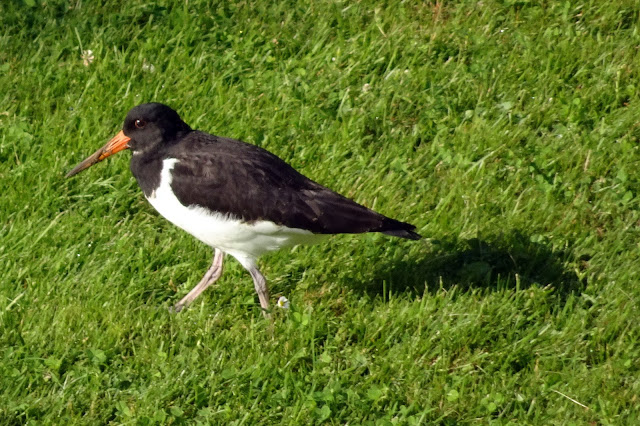As you've been able to gather from my recent posts: even if we had some rain here lately, it has hardly been of biblical Deluge proportions. So when this morning I spotted some Eurasian Oystercatchers (Haematopus ostralegus) on the lawn below my balcony, I kind of wondered if they too have come to rely on human weather apps for information, rather than going by their natural instincts... (The Swedish name for them is strandskata, which would literally translate as "Beach Magpie" in English.)
The lawns may have been given a decent watering over the past couple of days, but if they were hoping to find oysters, I think they must have been disappointed...
Just joking, of course. The river is only a few hundred meters away, and I have occasionally seen these birds around the neighbourhood before - even if not recently. They are rare guests compared to our usual everyday summer mix of seagulls, pigeons, magpies, crows and jackdaws. But yesterday morning, three or four visiting Oystercatchers seemed to have taken over the territory of this lawn from all the other kinds of big birds usually seen there, and had it all to themselves. And I found this interesting enough to go and fetch my Sony camera with some zoom possibilites, and snap a few photos...
Wikipedia tells me that despite the bird's name, oysters do not form a large part of the Oystercatcher's diet. It still lives up to its name, though, as few (if any) other wading birds are capable of opening oysters. It seems the shape of their bill can vary between individuals. Oystercatchers with broad bill tips open molluscs by prising them apart or hammering through the shell, whereas pointed-bill birds dig up worms.
So I guess what we see here is more a case of "the early bird hoping the catch the worm"...





They certainly make a change from the more usual neighbourhood birds.
ReplyDeleteJanice, they certainly stand out. The first time I saw one I had no idea what it was, but since I found out, I now recognise them easily :)
DeleteGood grief! I have never seen a Oyster Catcher on a grassy lawn! It looks so out of place!
ReplyDeleteGinny, when I moved here to live 17 years ago I'd never have thought I'd be seeing both hares and oystercatchers from my windows. (So far not at the same time, but still...)
DeleteWhat a delightful and thoughtful observation. Nature always surprises us, and it is lovely that you took the time to capture such rare visitors with your camera.
ReplyDeleteThanks Ro.
DeleteThank you for these great photos and the info about oyster catchers. In German, they are called Austernfischer, but of course they don't actually "fish" - they dig more than anything. Here, I am way too far away from seeing them in the wild; the nearest thing to "sea" birds we get here are some gulls from the river. To hear their typicall gull-cry is always a bit weird, even though I am used to it by now; it reminds me of holidays in Scarborough.
ReplyDeleteMeike, I too get "seaside holiday feelings" from hearing the gulls. A number of them always come up the river from the coast in spring to nest and bring up their young here over summer. For me their first arrival is always a sign of spring... They can indeed be a bit too noisy sometimes, especially in their "parenting" season when they hover above their young ones walking about on the ground. Some people complain about the gulls, but I'm sure I'd miss them if they didn't come. It's a bit like they bring a whiff of the seaside to me, when I can't go to the coast myself... ;-)
Delete